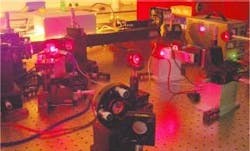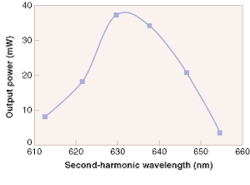Tunable Cr:forsterite laser produces orange-red
A physicist at Koç University (Istanbul, Turkey) has used frequency-doubled Cr:forsterite to produce radiation in the orange-red (600- to 650-nm) part of the spectrum with more power than produced previously.1 A variety of nonlinear conversion schemes have used periodically poled lithium niobate (PPLN) crystals in the past to produce orange-red output but were limited in efficiency and power. Alphan Sennaroglu believes the output he obtained is the highest second-harmonic-power generation ever achieved with a continuous-wave (CW) Cr:forsterite laser (see Fig. 1).
null
Tunable solid-state lasers of this color are still emerging as a practical source for use in color display technology, spectroscopy, and photodynamic therapy. "Such a source would be very important for display and medical applications," says Sennaroglu.
With a tuning range extending from 1130 to 1370 nm, the Cr4+:forsterite laser has shown potential in efficient frequency-doubled output from 565 to 685 nm, just outside the Ti:sapphire laser tuning range. The room-temperature continuous-wave orange-red laser demonstrated by Sennaroglu could be tuned from 613 to 655 nm (see Fig. 2).
null
One cavity in the intracavity device contained a 20-mm-long PPLN crystal with eight different gratings, each 450 µm in width. The grating periods ranged from 9.6 to 12.4 µm. The crystal was heated to 188°C to facilitate intracavity-frequency doubling. The light from a CW 1064-nm Nd:YAG resonated through the Cr:forsterite and PPLN setup and was tuned by a Brewster-cut SF-10 prism.
Attenuators varied the pump power level to enable efficiency measurements and optimize the polarization of the pump's electric field. The waist of the focused pump beam was 36 µm wide. Lasing occurred at 2.9 W of threshold pump power.
The obtained conversion efficiency of 0.24% agrees well with predicted theory, says Sennaroglu. Although there is room for improvement in efficiency, 45 mW of power is obtained at the second-harmonic-generation wavelength of 630 nm, better than any previous results using Cr:forsterite lasers, he reports.
Better focusing of the beam waist inside the PPLN crystal should increase efficiency, says Sennaroglu, as should stabilization of the fundamental wavelength by selective intracavity elements. Future plans are to do just that, and to scale down the laser system in size.
REFERENCE
- A. Sennaroglu, Appl. Opt. 41, 4356 (2002).


